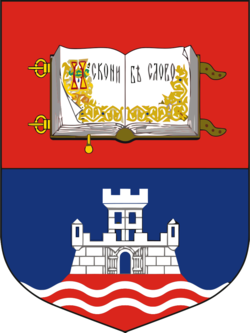Difference between revisions of "University of Belgrade"
(Created page with "{{group |wikipedia=https://en.wikipedia.org/wiki/University_of_Belgrade |website=http://bg.ac.rs/en/ |constitutes=university |leaders= |logo= |twitter= |start= |headquarters=B...") |
(unstub) |
||
| Line 4: | Line 4: | ||
|constitutes=university | |constitutes=university | ||
|leaders= | |leaders= | ||
| − | |logo= | + | |logo=Belgrade University coa.png |
|twitter= | |twitter= | ||
| − | |start= | + | |start=1808 |
|headquarters=Belgrade, Serbia | |headquarters=Belgrade, Serbia | ||
| + | |description=The oldest and largest modern university in [[Serbia]] | ||
}} | }} | ||
| + | The '''University of Belgrade''' is a [[List of universities in Serbia|public university]] in [[Serbia]]. It is the oldest and largest modern university in Serbia.<ref>https://books.google.com/books?id=LCPx0R1TqOMC&pg=PA65</ref>.<ref>https://books.google.com/books?id=JmFetR5Wqd8C&pg=PA560</ref> | ||
| + | |||
| + | ==History== | ||
| + | Founded in 1808 as the Belgrade Higher School in [[revolutionary Serbia]], by 1838 it merged with the [[Kragujevac]]-based departments into a single university. The University has around 97,700 enrolled students and over 4,800 members of academic staff. Since its founding, the University has educated more than 378,000 [[Bachelor's degree|bachelors]], around 25,100 [[Magister (degree)|magisters]], 29,000 [[Specialist degree|specialist]]s and 14,670 [[Doctorate|doctors]].<ref name="lkub">http://bg.ac.rs/sr/mediji/licna-karta.php</ref> The University comprises 31 faculties, 12 research institutes, the [[Belgrade University Library|university library]], and 9 university centres. The faculties are organized into 4 groups: social sciences and humanities; medical sciences; natural sciences and mathematics; and technological sciences. | ||
| + | |||
| + | In the 1960s and 70s, the University developed into a remarkable regional and international educational institution. Many students from other countries were trained there. In the socialist Yugoslavia, the University was expanded, but it was also exposed to state and ideological influence. It has also been the driving force for the establishment of almost all other universities in today's [[Serbia]], [[Montenegro]], [[North Macedonia]] and several universities in [[Bosnia and Herzegovina]].<ref>Kandić Ljubica, Istorija Pravnog fakulteta 1905-1941, ''Zavod za udžbenike Beograd'' (Belgrade, 2002),</ref> | ||
| + | |||
| + | In the mid-1990s, the University of Belgrade became an internationally recognized center of the political opposition in Serbia. Massive anti-government protests were staged by the Belgrade students and professors. The University's student organizations (especially "[[Otpor!]]")<ref>Šušak Bojana, An Alternative to War, In The Road to War in Serbia: Trauma and Catharsis, ed. Neboiša Popov (Budapest 2000), pp. 479–508, p. 500.</ref>, with significant covert funding from abroad, contributed to overthrowing the government. | ||
| + | |||
{{SMWDocs}} | {{SMWDocs}} | ||
==References== | ==References== | ||
{{reflist}} | {{reflist}} | ||
| − | |||
Latest revision as of 11:48, 14 March 2022
(University) | |
|---|---|
 | |
| Formation | 1808 |
| Headquarters | Belgrade, Serbia |
| The oldest and largest modern university in Serbia | |
The University of Belgrade is a public university in Serbia. It is the oldest and largest modern university in Serbia.[1].[2]
History
Founded in 1808 as the Belgrade Higher School in revolutionary Serbia, by 1838 it merged with the Kragujevac-based departments into a single university. The University has around 97,700 enrolled students and over 4,800 members of academic staff. Since its founding, the University has educated more than 378,000 bachelors, around 25,100 magisters, 29,000 specialists and 14,670 doctors.[3] The University comprises 31 faculties, 12 research institutes, the university library, and 9 university centres. The faculties are organized into 4 groups: social sciences and humanities; medical sciences; natural sciences and mathematics; and technological sciences.
In the 1960s and 70s, the University developed into a remarkable regional and international educational institution. Many students from other countries were trained there. In the socialist Yugoslavia, the University was expanded, but it was also exposed to state and ideological influence. It has also been the driving force for the establishment of almost all other universities in today's Serbia, Montenegro, North Macedonia and several universities in Bosnia and Herzegovina.[4]
In the mid-1990s, the University of Belgrade became an internationally recognized center of the political opposition in Serbia. Massive anti-government protests were staged by the Belgrade students and professors. The University's student organizations (especially "Otpor!")[5], with significant covert funding from abroad, contributed to overthrowing the government.
Alumni on Wikispooks
| Person | Born | Died | Nationality | Summary | Description |
|---|---|---|---|---|---|
| Mira Milosevich | Journalist Academic Polyglot | Polyglot fellow of the Integrity Initiative | |||
| Slobodan Milošević | 20 August 1941 | 11 March 2006 | Serbia | Former President of Serbia who died in custody, preempting his trial | |
| Dušan Popov | 10 July 1912 | 10 August 1981 | Serbia | Spook | A Serbian double agent who worked for the MI6 and Abwehr during World War II. |
| Boris Tadić | Serbia | Politician Deep state actor | Appointed to Serbian President after the Integrity Initiative had "expand[ed] his horizons" during a visit to London. | ||
| Zoran Đinđić | 1 August 1952 | 12 March 2003 | Serbia | Politician | Prime Minister of Serbia. Assassinated, not necessarily by his opponents: "the moor has done his duty. The moor can go".... |
References
- ↑ https://books.google.com/books?id=LCPx0R1TqOMC&pg=PA65
- ↑ https://books.google.com/books?id=JmFetR5Wqd8C&pg=PA560
- ↑ http://bg.ac.rs/sr/mediji/licna-karta.php
- ↑ Kandić Ljubica, Istorija Pravnog fakulteta 1905-1941, Zavod za udžbenike Beograd (Belgrade, 2002),
- ↑ Šušak Bojana, An Alternative to War, In The Road to War in Serbia: Trauma and Catharsis, ed. Neboiša Popov (Budapest 2000), pp. 479–508, p. 500.